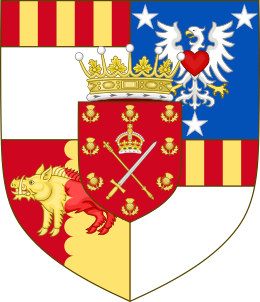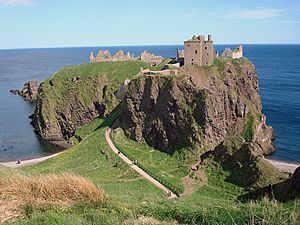Clan Keith facts for kids
Quick facts for kids Clan Keith |
|||
|---|---|---|---|
| Ceiteach | |||

Crest: Out of a crest coronet Or, a roebuck's head Proper, attired Or.
|
|||
| Motto | Veritas vincit (Truth conquers) | ||
| Slogan | A Keith, Veritas Vincit (also Truth Prevails) | ||
| War cry | A Keith, Veritas Vincit | ||
| Profile | |||
| Region | Lowlands and Highlands | ||
| District | East Lothian, Aberdeenshire (lowlands), and Caithness (highlands) | ||
| Plant badge | White Rose | ||
| Animal | Badger | ||
| Chief | |||
 |
|||
| Sir James William Falconer Keith of Urie, 14th Earl of Kintore | |||
| Earl of Kintore Lord Keith of Inverurie and Keith Hall Viscount Stonehaven Baron Stonehaven Baronet 6th of Ury |
|||
| Seat | Keith Hall, Aberdeenshire | ||
| Historic seat | Keith Marischal House Dunnottar Castle Fetteresso Castle |
||
| Last Chief | Michael Keith, 13th Earl of Kintore | ||
|
|||
|
|||
|
|||
|
|||
Clan Keith is a Scottish clan from both the Highlands and Lowlands. Historically, its chief held the important title of Marischal. This role later became Great Marischal, then Earl Marischal of Scotland.
Contents
History of Clan Keith
How the Clan Started
The name Keith comes from an old word meaning "wood".
A brave warrior from the Chatti tribe is said to have defeated a Danish general named Camus in 1010. This happened at the Battle of Barrie. For his courage, Malcolm II of Scotland honored him. The warrior was called Marbhachair Chamuis, which means the Camus Slayer.
The chief of Clan Keith has shown three lines on their shield ever since. You can see this on a seal from 1316 belonging to Sir Robert de Keith.
King Malcolm's victory in 1018 gave him control of Lothian. The Camus Slayer received lands in Lothian. His family later took the name Keith from these lands.
Around 1150, a Norman adventurer named Hervey married the native heiress of the Camus Slayer. David I of Scotland gave her a special document for the Keith lands.
In 1176, their son was known as Marischal of the King of Scots. The Marischal's job was to protect the king during Parliament. They also looked after the king's special items, like the royal crown.
Clan Crest and Motto
The clan crest shows a roe deer, also known as a roebuck. The Keith Clan Motto is Veritas Vincit. This means "Truth Conquers".
Wars for Scottish Independence
In 1308, Robert the Bruce gave land in Aberdeenshire to his friend, Robert de Keith. Here, the Marischal built his castle.
Robert de Keith's nephew, William Keith of Galston, carried Bruce's heart back to Melrose Abbey. This happened after Sir James Douglas died in battle.
King Robert the Bruce confirmed the family's special role as Marischal in 1324. Sir Robert de Keith had led the Scottish cavalry at the Battle of Bannockburn. The family kept this role as long as they used the ancient shield design.
Sir Robert Keith, the Marischal, helped the young David II of Scotland escape to France. This was to avoid Edward Balliol who was trying to take the throne.
15th Century and Clan Conflicts
The Clan Keith often had feuds with the nearby Clan Irvine. In 1402, Clan Irvine is said to have attacked and defeated a war party of Clan Keith. This event was known as the Battle of Drumoak.
Sir William Keith, the Marischal, died in 1407. He married the heiress of Sir Alexander Fraser. This marriage added large estates in Buchan, Kincardine, and Lothian to his family's lands.
William's brother, John Keith, married the Cheyne heiress. This brought the Keiths huge estates in Inverugie. It also included Inverugie Castle, which later became a main home for the clan chiefs.
Around 1458, the heir of the Marischal was made the 1st Earl Marischal. He was the only noble to be named after his important state job.
A branch of Clan Keith lived in Caithness. They fought at the Battle of Tannach (around 1464). They helped the Clan Mackay against the Clan Gunn.
They later fought another battle against the Gunns, called the Battle of Champions (around 1478). This battle was between twelve men of Clan Gunn and twenty-four men of Clan Keith. All the Gunns, including their chief, were killed. However, Keith of Ackergill was soon killed by the Gunns in a revenge attack.
16th and 17th Centuries

William Keith, the 3rd Earl Marischal, invited John Knox, a religious reformer, back to Scotland in 1559. William Keith, 4th Earl Marischal, founded the Marischal College in Aberdeen.
George Keith, 5th Earl Marischal, traveled to Denmark. This trip led to the marriage of James VI of Scotland to Anne of Denmark.
After Charles II of England became king in 1651, William Keith, 7th Earl Marischal, was captured. He was held in the Tower of London. He stayed there until the king returned to power. The king then made him a Privy Councillor and Lord Privy Seal. This was to make up for what he and his family had suffered.
After Charles's crowning, the Scottish crown jewels were hidden on Keith lands. Because of this, Marischal's brother, John Keith, was made Knight Marischal and Earl of Kintore.
18th Century and Jacobite Risings
George Keith, the 8th Earl Marischal, was given a special honor by James Francis Edward Stuart (the Old Pretender). During the Jacobite rising of 1715, Clan Keith supported the Jacobite cause.
As a result, George Keith, 10th Earl Marischal, and his brother, James Francis Edward Keith, lost their lands, castles, and titles. However, the two Keith brothers played important roles in Europe. The earl was one of the few Jacobite Knights of the Garter. He also received the highest honor in Prussia. His brother was given Russia's highest honor.
In 1801, the Lord Lyon King of Arms recognized Keith of Ravelston and Dunnotter. His nephew was made Knight Marischal in 1822. This was for King George IV's visit to Edinburgh.
Algernon Hawkins Thomond Keith-Falconer, 9th Earl of Kintore, spent a lot of money. This greatly reduced the Kintore estates. However, Sir James Ian Baird of Urie, the 12th Earl of Kintore, promoted the clan around the world. He appointed a Seanchaí (storyteller) to keep their history and traditions alive.
In 1978, the Chief of Clan Keith and the Commander of Clan Gunn signed a peace treaty. This happened at the site of the Chapel of St. Tayrs. It ended a feud between the two clans that had started in 1478.
In 2002, the 13th Earl of Kintore, who was the previous Chief of Clan Keith, signed a peace treaty. He did this with the previous Chief of Clan Irvine. The ceremony took place by the River Dee. This ended their 600-year feud.
Clan Chief
The current Chief of Clan Keith is Sir James William Falconer Keith of Urie. He is the 14th Earl of Kintore. He was born on April 15, 1976.
Clan Castles
- Keith Marischal House, located near Pencaitland, East Lothian, is a tower house from the 1500s. It stands where an older Keith castle was built in the 1300s.
- Dunnottar Castle sits on a high cliff by the sea, south of Stonehaven, Kincardineshire. There has been a fortress here since the 1100s. The Keiths took control of it in 1382. The castle ruins today include a tower, courtyard, and chapel. The entrance is a steep path through a tunnel.
King Donald II died here in 900. William Wallace captured the castle from the English in 1297. Mary, Queen of Scots visited in 1562. James Graham, 1st Marquess of Montrose tried to capture it in 1645 but failed.
William Keith, the 9th Earl Marischal, hosted Charles II of England at the castle in 1650. The Scottish crown jewels were hidden here when Oliver Cromwell invaded in 1651. Cromwell attacked the castle in 1652. It surrendered after eight months due to hunger and a rebellion. The castle was held for William of Orange in 1689. Many Jacobites were imprisoned there.
- Keith Hall in Aberdeenshire, once called Caskieben, is the current home of the Clan Keith chief. It is a tower house from the 1500s.
- Fetteresso Castle passed from the Clan Strachan to the Clan Keith chief, the Earl Marischal, in the early 1300s.
- Ackergill Tower, north of Wick, Caithness, is a tower and mansion from the 1400s. It has five stories. It was first held by the Cheynes but passed to the Keith Earls Marischal around 1350. The Keiths in Caithness had a long feud with the Clan Gunn. In 1556, the Keiths were attacked in the castle by the Clan Sinclair. They eventually sold it to them in 1612.



